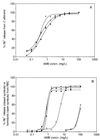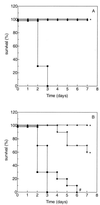Mild heating of amphotericin B-desoxycholate: effects on ultrastructure, in vitro activity and toxicity, and therapeutic efficacy in severe candidiasis in leukopenic mice
- PMID: 10817715
- PMCID: PMC89919
- DOI: 10.1128/AAC.44.6.1598-1603.2000
Mild heating of amphotericin B-desoxycholate: effects on ultrastructure, in vitro activity and toxicity, and therapeutic efficacy in severe candidiasis in leukopenic mice
Abstract
Heated (20 min at 70 degrees C) amphotericin B-desoxycholate (hAMB-DOC) was further characterized, as was another formulation obtained after centrifugation (60 min, 3000 x g), hcAMB-DOC. Conventional AMB-DOC consisted of individual micelles (approximately 4 nm in diameter) and threadlike aggregated micelles, as revealed by cryo-transmission electron microscopy. For both hAMB-DOC and hcAMB-DOC, pleiomorphic cobweb structures were observed with a mean particle size of approximately 300 nm as determined by laser diffraction. The potent antifungal activity of AMB-DOC against Candida albicans is not reduced by heating. Effective killing of C. albicans (>99.9% within 6 h) was obtained at 0.1 mg/liter with each of the AMB formulations. For AMB-DOC, hAMB-DOC, and hcAMB-DOC, cation release ((86)Rb(+)) from C. albicans of > or =50% was observed at 0.8, 0.4, and 0.4 mg/liter, respectively. After heating of AMB-DOC, toxicity was reduced 16-fold as determined by red blood cell (RBC) lysis. For AMB-DOC, hAMB-DOC, and hcAMB-DOC, hemolysis of > or =50% was observed at 6.4, 102.4, and 102.4 mg/liter, respectively. In contrast, AMB-DOC and its derivates showed similar toxicities in terms of cation release from RBC. For AMB-DOC, hAMB-DOC, and hcAMB-DOC, cation release ((86)Rb(+)) of > or =50% was observed at 1.6, 0.8, and 0.8 mg/liter, respectively. In persistently leukopenic mice with severe invasive candidiasis, higher dosages of both hAMB-DOC and hcAMB-DOC were tolerated than those of conventional AMB-DOC (3 versus 0.8 mg/kg of body weight, respectively), resulting in significantly improved therapeutic efficacy. In conclusion, this new approach of heating AMB-DOC may be of great value for further optimizing the treatment of severe fungal infections.
Figures




Similar articles
-
In-vivo therapeutic efficacy in experimental murine mycoses of a new formulation of deoxycholate-amphotericin B obtained by mild heating.J Antimicrob Chemother. 1998 Dec;42(6):779-85. doi: 10.1093/jac/42.6.779. J Antimicrob Chemother. 1998. PMID: 10052902
-
Amphotericin B liposomes with prolonged circulation in blood: in vitro antifungal activity, toxicity, and efficacy in systemic candidiasis in leukopenic mice.Antimicrob Agents Chemother. 1995 Sep;39(9):1954-8. doi: 10.1128/AAC.39.9.1954. Antimicrob Agents Chemother. 1995. PMID: 8540697 Free PMC article.
-
Supramolecular Chitosan Micro-Platelets Synergistically Enhance Anti-Candida albicans Activity of Amphotericin B Using an Immunocompetent Murine Model.Pharm Res. 2017 May;34(5):1067-1082. doi: 10.1007/s11095-017-2117-3. Epub 2017 Feb 6. Pharm Res. 2017. PMID: 28168390
-
Amphotericin B and its new formulations: pharmacologic characteristics, clinical efficacy, and tolerability.Transpl Infect Dis. 1999 Dec;1(4):273-83. doi: 10.1034/j.1399-3062.1999.010406.x. Transpl Infect Dis. 1999. PMID: 11428998 Review.
-
Recent developments on the anti-Candida effect of amphotericin B combined with a second drug - a mini-review.An Acad Bras Cienc. 2023 May 8;95(1):e20220033. doi: 10.1590/0001-3765202320220033. eCollection 2023. An Acad Bras Cienc. 2023. PMID: 37162085 Review.
Cited by
-
To heat or not to heat: the impact of temperature on the aggregation state of amphotericin B in drug delivery systems.Nanomedicine (Lond). 2024;19(24):1953-1956. doi: 10.1080/17435889.2024.2382669. Epub 2024 Aug 9. Nanomedicine (Lond). 2024. PMID: 39119655 No abstract available.
-
Amphotericin B Nano-Assemblies Circumvent Intrinsic Toxicity and Ensure Superior Protection in Experimental Visceral Leishmaniasis with Feeble Toxic Manifestation.Vaccines (Basel). 2023 Jan 1;11(1):100. doi: 10.3390/vaccines11010100. Vaccines (Basel). 2023. PMID: 36679946 Free PMC article.
-
Liposomal Amphotericin B for Treatment of Leishmaniasis: From the Identification of Critical Physicochemical Attributes to the Design of Effective Topical and Oral Formulations.Pharmaceutics. 2022 Dec 28;15(1):99. doi: 10.3390/pharmaceutics15010099. Pharmaceutics. 2022. PMID: 36678729 Free PMC article. Review.
-
Amphotericin B release rate is the link between drug status in the liposomal bilayer and toxicity.Asian J Pharm Sci. 2022 Jul;17(4):544-556. doi: 10.1016/j.ajps.2022.04.007. Epub 2022 Jun 8. Asian J Pharm Sci. 2022. PMID: 36105314 Free PMC article.
-
Lipid Systems for the Delivery of Amphotericin B in Antifungal Therapy.Pharmaceutics. 2020 Jan 1;12(1):29. doi: 10.3390/pharmaceutics12010029. Pharmaceutics. 2020. PMID: 31906268 Free PMC article. Review.
References
-
- Gaboriau F, Chéron M, Leroy L, Bolard J. Physicochemical properties of the heat induced ‘super’ aggregates of amphotericin B. Biophys Chem. 1997;66:1–12. - PubMed
-
- Hiemenz J W, Walsh T J. Lipid formulations of amphotericin B: recent progress and future directions. Clin Infect Dis. 1996;22(Suppl. 2):S133–S144. - PubMed
-
- Juliano R L, Grant C W M, Barber K R, Kalp M A. Mechanism of the selective toxicity of amphotericin B incorporated into liposomes. Mol Pharmacol. 1987;31:1–11. - PubMed
-
- Leenders A C, de Marie S. The use of lipid formulations of amphotericin B for systemic fungal infections. Leukemia. 1996;10:1570–1575. - PubMed
MeSH terms
Substances
LinkOut - more resources
Full Text Sources
Medical

